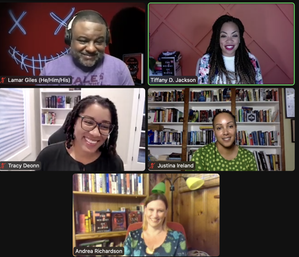 "I wanted to see a young Black girl in horror make it to the end," Tiffany D. Jackson said of her book The Weight of Blood (Katherine Tegen, Sept. 6). At the author dinner for Day 2 of NAIBA/SIBA's virtual programming last week, moderator Andrea Richardson, general manager of Fountain Bookstore, Richmond, Va., had asked Jackson why she wrote for young adults. Jackson's novel features a biracial teenage girl at a Georgia high school during the first year of an integrated prom, and she gave a nod to Stephen King's Carrie. "This is the first time I'm writing about racism," Jackson said. She wanted to ask readers, "What can revenge truly look like, and do we want that?"
"I wanted to see a young Black girl in horror make it to the end," Tiffany D. Jackson said of her book The Weight of Blood (Katherine Tegen, Sept. 6). At the author dinner for Day 2 of NAIBA/SIBA's virtual programming last week, moderator Andrea Richardson, general manager of Fountain Bookstore, Richmond, Va., had asked Jackson why she wrote for young adults. Jackson's novel features a biracial teenage girl at a Georgia high school during the first year of an integrated prom, and she gave a nod to Stephen King's Carrie. "This is the first time I'm writing about racism," Jackson said. She wanted to ask readers, "What can revenge truly look like, and do we want that?"
 Lamar Giles taps into similar themes for The Getaway (Scholastic, Sept. 20), in which hero Jay is working at Karloff Country, a world-famous resort. Life isn’t so great for the rest of the world, but people come to Karloff to escape--until it begins to feel like a trap. "How do kids handle the monstrous forces around us?" Giles wanted to explore in his book. "And what are you willing to trade for comfort?" His first taste of horror was The Mysteries of Harris Burdick by Chris Van Allsburg. Like Jackson, he moved on to Stephen King and then to F. Paul Wilson. "I wanted to be a horror writer from the beginning," Giles said.
Lamar Giles taps into similar themes for The Getaway (Scholastic, Sept. 20), in which hero Jay is working at Karloff Country, a world-famous resort. Life isn’t so great for the rest of the world, but people come to Karloff to escape--until it begins to feel like a trap. "How do kids handle the monstrous forces around us?" Giles wanted to explore in his book. "And what are you willing to trade for comfort?" His first taste of horror was The Mysteries of Harris Burdick by Chris Van Allsburg. Like Jackson, he moved on to Stephen King and then to F. Paul Wilson. "I wanted to be a horror writer from the beginning," Giles said.
The alternate America in 1937 featured in Justina Ireland's Rust in the Root (Balzer + Bray/Harperteen, Sept. 20) is similarly divided; rather than geographically, as in Giles's novel, hers is divided into those who work the mystical arts and those who do not. Laura, the main character, is in a transitional period and must determine "how important a community is, how to build one, how to keep one." When Richardson asked Ireland about the presence of adult mentors in many of her books, Ireland said, "Sometimes progress is slow, and we need older people to tell us we have made progress, but there's more to be done."
Tracy Deonn's Bloodmarked (Simon & Schuster, Nov. 8), the second in her Legendborn Cycle, continues her reimagining of the Arthurian legend as a contemporary fantasy with teenage Bree's Southern Black girl magic at its core. "Contemporary fiction and fantasy are my faves, and I press hard on both," Deonn said. "Agents of white supremacy are as big as hellhounds in the woods." Like Ireland, Deonn sees the generations who came before as key to what Deonn calls her "intergenerational trauma squad." She said, "Teens are realizing they're inheriting this trauma. The meat of the story is from Bree's point of view, but there's a heavy presence of the generations before, the stories before; their legacy is still a heavy weight." --Jennifer M. Brown

